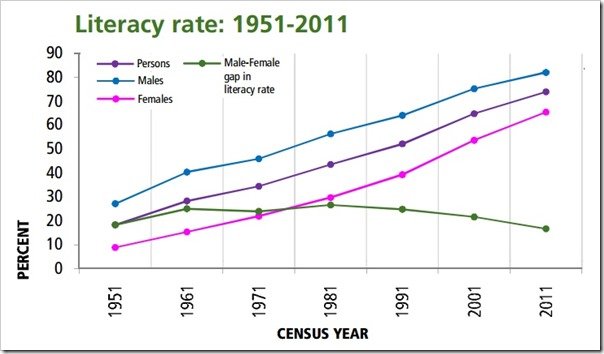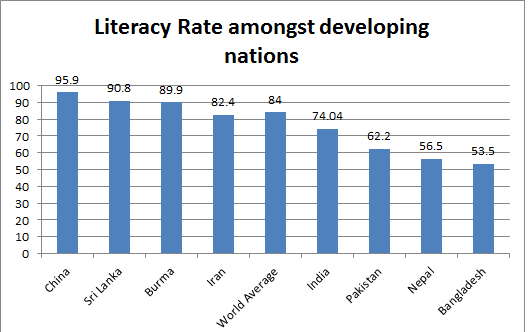“Live as if you were to die tomorrow, Learn as if you were to live forever”- Mahatma Gandhi
Knowledge is power and education helps us to gain that power. I believe education occurs through any event or experience that has a positive influence on our thinking or action. There is no formal beginning of the event when an individual starts educating oneself. It begins right at the moment when a child learns to crawl or to utter a syllable for the first time. But in technical terms, education can be defined as the formal process by which an institution or an individual transfers its accumulated knowledge, skills and values to another.
Indian education system dates back to almost 3rd century when sages and scholars delivered their learning orally and religious myths were scripted down in palm leaves or barks of trees. Today Indian education system is much more organized and effective. India has made a considerable progress in educating its citizens and to make them aware of the importance of education. Let us look at some of the stats regarding the education system of our country.
Literacy rate of India
Literacy rate of a country definitely marks the socio-economic progress of a nation and presently the Indian literacy rate has grown to 74.04% (2011 figure) from 12% at the end of British rule in 1947.Still it is way below the world average literacy rate which is 84%. And sadly India also lists among the nations with largest illiterate population. There is a also a wide gender disparity in the literacy rate in India: effective literacy rates (age 7 and above) in 2011 were 82.14% for men and 65.46% for women.

India’s stand among other developing nations in terms of literacy rate
Shockingly India ranks 168th among 234 countries of the world in terms of literacy rate and ranks 6th among the developing nations.

Reservation and Quota system in India
While this system has facilitated education for the lower class of the society easily it has also given rise to a lot of disputes. Almost in every school and colleges there is reservation for the different sectors of people. And by this they enjoy an edge over other equally talented individuals. The original idea behind providing reservations was to provide level playing field for the downtrodden classes of the society. It was earlier decided that all efforts will be taken to improve the environment, education system and social status of these classes; after the goal is met then the reservation will be phased out. But now it seems to be for eternity and has proved to be a menace for the education system.
Budgets
Education in India is provided by both Private and Public sector and the funds come from different sources such as Central, State and Local. The present total government spending (Centre and States combined) on education accounts for about 3.7 % of GDP (as of 2009-10), which is way below the benchmark of 6 % of GDP that had been recommended more than 40 years ago. As a share of the GDP, the allocations have witnessed only a slight hike from 0.69 % of the total budget (in 2011-12 RE) to 0.73 % in 2012-13 BE.
The facts mentioned above are definitely disappointing and need further attention. Lets now look at how different is India’s education system from other nations.
Like almost all other countries, Primary and Secondary education forms the base of Indian education system. But there are significant differences found when compared to education systems of the most educated countries of the world.
• Indian education is mostly exam oriented while others’ are practical learning oriented.
• When it comes to maintenance and proper infrastructure of government schools, the scenario is poor in India.
• There is also a dearth of qualified professionals or teachers in government schools of India.
• Funds allocated for improving the system are many a time misutilized and don’t serve the purpose.
• The employment opportunities offered by colleges of India after acquiring technical or other professional skills are not very fair. There is a mushroom growth of engineering colleges in the country with almost zero employment opportunities offered by the institutions for the students.
• The class size is also another problem and the student to teacher ratio is very high.
• Lack of awareness programme about the value of education in the rural areas.
• Education in many parts of the country is gender biased and offer little opportunities for the female population.
So definitely there are a lot many reasons to ail and Indian education system has a long way to go in enlisting the nation among the list of educated countries of the world. The goal of true education lies not only in developing the intelligence of the mass but also building the character of the individual. It’s highly required that the importance of education is spread nationwide and proper measures be taken to increase the country’s literacy rate. Along with that corruption in process of fund distribution must be acted upon with strong hands. Also women education needs special attention. There is a saying “You educate a man; you educate a man. You educate a woman; you educate a generation.” A country’s literate population is its asset and helps it in its progress.
As Socrates said “Education is the kindling of a flame, not the filling of a vessel.”
References used
http://www.downtoearth.org.in/content/12th-five-year-plan-spend-highest-ever-development
http://www.whichcountry.co/education-in-different-countries/
http://www.indiaonlinepages.com/population/literacy-rate-in-india.html
You might like reading:

How Glocalisation is changing the world of marketing !
“The whole pace of business is moving faster. Globalization is forcing companies to do things in new ways.” -Bill Gates The world has shrunk. The seven seas are no more capable of keeping people distant. Nor are they able to keep them away from products developed in different lands. So today you can find McDonalds, KFCs, and Starbucks etc. in places […]

10 Amazing Branding Campaigns Of Pepsi Cola
Pepsi Cola is undoubtedly one of the most popular aerated beverages in the world. The drink was invented in the year 1893 by pharmacist Calhem Bradham as a digestive aid. The brand that we see has a long history during which it transformed itself as a popular consumer product and part of a global food and beverages empire. Here are […]






























